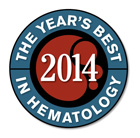Regular prophylactic factor infusion reduces bleeding, improves joint health, and has become standard of care in the management of patients with severe hemophilia A and B. However, the inconvenience of frequent intravenous administration is an important source of patient dissatisfaction and nonadherence. Most patients must infuse two to three times weekly to maintain hemostatic trough levels due to the relatively short half-lives of factor VIII (~12 hours) and factor IX (~20 hours). The arrival of long-acting factor concentrate has been anxiously anticipated as a means of enhancing the convenience of, and adherence to, therapy. In 2014, long-acting factor IX concentrate arrived.
In a phase III study, two prophylactic regimens of a recombinant factor IX Fc fusion protein (eftrenonacog alfa; Alprolix) were tested. Group 1 received a starting dose of 50 IU/kg weekly. Group 2 received a starting dose of 100 IU/kg every 10 days. In group 1, the dose was adjusted, and in group 2, the dosing interval was adjusted to maintain trough factor IX levels of 1 to 3 IU/mL. The mean terminal half-life of eftrenonacog alfa was 82.1 hours. The median annualized bleeding rates in groups 1 and 2 were 3.0 and 1.4, respectively. In group 2, 53.8 percent of patients achieved dosing intervals of 14 days or greater by the end of the study.1 Patients who transitioned from prophylaxis with recombinant factor IX (pre-study) to prophylaxis with eftrenonacog alfa (on study) had fewer bleeding episodes despite reduced infusion frequency and overall factor consumption.2 In March 2014, eftrenonacog alfa became the first long-acting factor concentrate to be approved by the U.S. Food and Drug Administration (FDA). Several months later, results of a phase III study of glycopegylated recombinant factor IX (nonacog beta pegol; N9-GP) were reported. Previously treated patients with severe hemophilia B were assigned to one of two prophylactic regimens: 10 IU/kg weekly or 40 IU/kg weekly. The annualized bleeding rate was 2.93 and 1.04 in the two groups, respectively. Two-thirds of patients in the 40 IU/kg group did not have a single bleed into a target joint over the yearlong study. The mean steady-state half-life of nonacog beta pegol was 107 to 111 hours.3 No inhibitor formation occurred in patients treated with either long-acting factor concentrate.
Half-life prolongation of factor VIII has proven more difficult. Recombinant factor VIII Fc fusion protein, the first long-acting factor VIII molecule to receive FDA approval (in June 2014), has a mean terminal half-life of 19.0 hours and requires administration every three to five days for prophylaxis in most patients.4
As honorable mentions for best of 2014, it is worth highlighting the work of Dr. Scot Fahs et al and Dr. Lesley Everett et al. In patients with liver disease, factor VIII levels are characteristically preserved, but other clotting proteins synthesized by hepatocytes are diminished. So where is factor VIII made? Elegant murine studies by two groups have at last solved the mystery. In one study using a Cre/lox-dependent conditional knockout model, knockout of factor VIII from endothelial cells but not hepatocytes produced a hemophilia A phenotype.5 In another model, knockout of Lman1 (which is essential for secretion of factor VIII into the circulation) from endothelial cells, but not hepatocytes, reduced factor VIII levels in plasma.6 Collectively, these studies confirm that endothelial cells, and not hepatocytes, are the primary cellular origin of factor VIII.
Also important to mention is the work of Dr. Marc Righini and colleagues on age-adjusted D-dimer for exclusion of pulmonary embolism. A D-dimer < 500 μg/L measured using a high-sensitivity assay system is a robust means of excluding pulmonary embolism in patients with a low pretest probability of PE, obviating the need for CT-pulmonary angiography. However, the specificity of a fixed cut-off of 500 μg/L is low in elderly patients because D-dimer values increase with age. In a prospective multicenter study, use of an age-adjusted D-dimer cut-off (age × 10) in patients older than 50 years reliably excluded pulmonary embolism and reduced unnecessary imaging compared with a fixed cut-off of 500 μg/L.7
Looking forward to 2015, treatment options for post-thrombotic syndrome (PTS) are limited. Pharmacomechanical catheter-directed thrombolysis (PCDT) in patients presenting with acute proximal deep vein thrombosis (DVT) may reduce the frequency or severity of PTS. In the ATTRACT trial, patients with acute proximal DVT are randomized to PCDT plus standard care (anticoagulation and elastic compression stockings) or standard care alone. The primary outcome is development of PTS within two years. Bleeding and other safety outcomes are also assessed. Growing evidence suggests that perioperative bridging anticoagulation is overused in clinical practice and associated with increased bleeding. In the PERIOP-2 trial, patients on warfarin for atrial fibrillation or mechanical heart valves who require interruption of anticoagulation for an invasive procedure are randomized to postoperative low molecular weight heparin bridging or placebo. The primary outcome is thromboembolism at 90 days and bleeding will also be recorded.
References
Competing Interests
Dr. Cuker indicated no relevant conflicts of interest.

